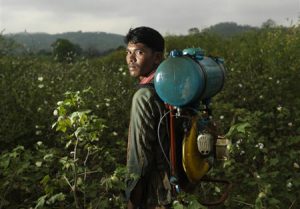A common argument from industry and business leaders is that the irrational fears of the public and NGOs lead to unnecessary caution in European policymaking. While commentators in China urge tighter regulation on issues like food safety, Europe in particular is accused of regulating against non-existent risks, based on unwarranted public fears.
Genetically modified crops is one example where US officials, together with biotech giant Monsanto, have frequently criticised the EU, even going so far as to urge retaliation according to leaked diplomatic cables.
This fear of food safety and environmental hoaxes is misplaced, however, according to new research by the European Environment Agency.
In an analysis of 88 historic examples labelled as unfounded health scares or environmental hoaxes or myths, researchers found just four "false alarms".
In about one-third of examples, there is scientific evidence available to show there was a real risk and that a lack of regulatory intervention could have led to adverse effects on human health or the environment. In another third of cases "the jury is still out" on whether there will be harm, says the report.
Acid rain and nuclear
One example cited is acid rain. The 1980s saw a swell of concern that emissions of sulphur and nitrogen were converting into acidic rain, snow or fog, posing a threat to human health and the environment. Although acid rain has not been found to threaten crops, lakes or human health, it has damaged some forest ecosystems, something that might have been more widespread if regulation to cut emissions had not taken place.
In another example, the authors look at the argument that precautionary decisions to halt nuclear plant construction in the US after the 1979 Three Mile Island incident were not justified by the risks to those living near plants, or the risks of accidents at plants. A recent long-term study found no increased risk of leukaemia among children in the proximity of nuclear power plants in the UK.
However, the report says, a cautious attitude towards nuclear power may still be justified.
"It is worth asking whether the risks to those living near nuclear plants are, indeed, insufficient to justify a precautionary moratorium. There is little doubt, for example, that a major reactor accident could release large amounts of radiation into the environment, as was demonstrated during the nuclear disasters at Chernobyl, Ukraine, in 1986 and more recently at Fukushima, Japan, in 2011.
"Dispute seems to centre on the likelihood of such an event and there seems to be a significant disagreement between expert and lay perceptions of risk," says the report.
The probability of a Three Mile Island accident being repeated anywhere has been estimated in the range of 1 in 250 to 1 in 25,000 reactor-years. However, these estimates do not take account the possibility of human error. The US Nuclear Regulatory Commission has indicated that there is a 50% chance of a nuclear accident equal in size to Three Mile Island or larger.
As well as accidents, there is also the issue of radioactive waste and ongoing disagreement about how to dispose of it. Given this, precautionary attitudes to nuclear plant construction do not seem irrational, concludes the report.
Meat and cancer links
A final interesting example concerns food safety, and the use of nitrates in meat preservation, which help add flavour and inhibit the growth of toxins and fatal forms of food poisoning like botulism. The excellent safety record of cured meat has been largely attributed to the use of nitrates.
However, nitrates have been found to react in the body with other food agents to form nitrosamines, which are known carcinogens, leading to repeated calls to ban them. Rather than being an unfounded food safety scare, the decision not to ban nitrates can be seen as an example of risk-trade offs, with food safety officials deciding the increased risk of botulism was greater than the risk of cancer.
The lack of false alarms in recent history has led the report authors to suggest fears of over-precaution are misplaced.
"Decision-makers often worry about taking too much precaution but seem to lack similar concerns about not taking enough. This tendency has developed despite evidence that the costs of not taking precautionary action are substantial — both economically and socially and despite the many identified benefits of preventive regulation with regards to health, safety and the environment."



